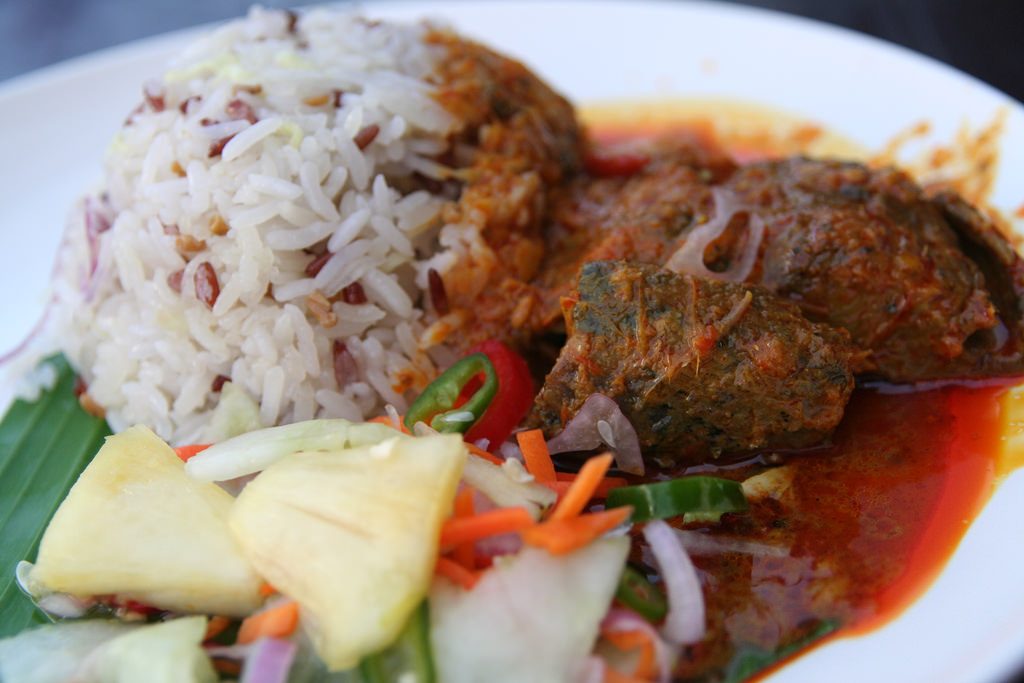
Photo Credit: Flickr / Daniel Goh
Must Try Malay Cuisine in Malaysia
Malay, as a race, can be divided into many smaller ethnic groups ranging from Acheh, Bugis, Mandailing, Minang, Banjar, Jawa and more. So it is no surprise that the intermarriages between these ethnic groups coming from all over the Southeast Asian archipelago has resulted in the rich food culture in Malaysia.
While each tribe has their own spread of traditional food, Malay cuisine in Malaysia bears many similarities to Indonesian cuisine. It has also been influenced by Chinese, Indian, Thai and many other cultures throughout history, producing a distinct cuisine of their own. In a traditional Malaysian Malay meal, rice is considered the centerpiece of a meal, with everything else, whether it be meats or vegetables, are considered as an accompaniment.
For the uninitiated, many Malay dishes revolve around rempah, or spices. These spices, not to be confused with herbs, are usually sauteed in oil to draw out flavours to form the base of a dish. So for the adventurous eaters, you might want to keep a bottle of water ready, because Malaysian Malay dishes often pack quite a punch. Here are some must-trys;

Photo Credit: Flickr / Selinz
Nasi dagang
Rice cooked with coconut milk and fenugreek seeds, served with a fish gulai (a rich, spicy and succulent curry-like sauce), fried shaved coconut, hard-boiled eggs and vegetable pickles. Nasi dagang is directly translated to trader’s rice in English, is a staple breakfast dish in northeastern states like Kelantan and Terengganu. If you’re ever ordering up a plate, don’t be alarmed if you find a purplish hue to your rice. The Kelantanese variety of nasi dagang often uses a type of local wild rice that has a light purple colour. It may look a little unorthodox, but its lightly glutinous characteristic adds an extra layer of texture to the dish.

Photo Credit: Flickr / Azfar Ahmad
Nasi lemak
While nasi dagang is a must try rice and dish meal, it should not be confused with nasi lemak. This Malay fragrant rice dish cooked in coconut milk and pandan leaf is what many would consider to be the national dish of Malaysia. Its name in Malay literally means “oily or fatty rice”. This name is derived from the cooking process where the rice is soaked in coconut cream. Traditionally, nasi lemak is served with sambal, a hot spicy sauce and includes various garnishes, including fresh cucumber slices, small fried anchovies, roasted peanuts, and hard-boiled or fried egg.
As a more substantial meal, nasi lemak is also served with additional protein dishes such fried chicken, sambal sotong and even rendang, a spicy meat and coconut milk stew.

Photo Credit: Flickr / Marpa87
Satay
One of Malaysia’s most popular foods, Satay is made from marinated meat pieces skewered with wooden sticks and grilled over a charcoal fire. It is typically served with compressed rice (ketupat), cut onions, cucumber, and a spiced peanut gravy. The town of Kajang in Selangor is famous for its satay, with the meat chunks thicker than the regular satay skewers and the chunky peanut sauce served along with a portion of fried chilli paste for that extra kick of spice.

Photo Credit: Hungry Onion
Air Bandung
To wash it all down, or just as a sweet accompaniment to all those savoury flavours, air bandung is a popular drink to pair with meals in the hot and humid Malaysian weather. This distinctly pink drink is a simple cold milk beverage flavoured with rose cordial syrup, which despite its name, has no connection to the city of Bandung in Indonesia.
